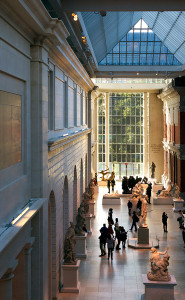Thomas Struth at the Met
http://www.metmuseum.org/exhibitions/listings/2014/thomas-struth
I am familiar with Struth’s work and so wasn’t surprised by the large scale ‘museum goer’ type pictures. They looked good and needed to be big to see the people in the images who were so dwarfed by the structures they were in.
I was more interested though in a series of images taken at the crossroads of various New York streets in the late 1970s. In black and white and all set with the same camera position, the pictures are not of anything but of everything!
They look down the middle of the street, indeed Struth must be standing in the middle of the road, not really focusing on anything in particular, each picture shot the same, but of course each wildly different too as the buildings on each side of the street are occupy different space and shapes. Sometimes it looks like a building is at the end of some of the streets. Each photograph is mounted separately on the gallery wall, but hung loosely in a grid. This display is reminiscent of the Struth’s teachers the Bechers and their watertowers.
http://www.guggenheim.org/new-york/collections/collection-online/artwork/500
Like Bernd and Hilla Becher’s works we are confronted with having to make comparisons between the images. Unlike the Bechers though where the subject is centrally placed, with Struth’s photographs we have a one point perspective as our subject, which we can see through, and choose to search around the edges of, to find the city in all its organized randomness.
A really interesting collection both for the photographic concept and the subject matter.
Streets of New York http://www.thomasstruth32.com/smallsize/photographs/streets_of_new_york_city/index.html
If we go back to the ‘museum’ pieces though, I had my own little Struth photographic experience as I walked the sloping ramp to the gallery. As I passed the windows overlooking the sculpture courtyard, I stopped to look out of the window. The light was just right. Late afternoon. People mingling, taking photographs, sitting. They were almost silhouetted. But some of those people weren’t museum visitors they were art works, in black.
The play between the people and the statues intrigued me. I had to look, which was which? Some repetition. I looked to the right, a statue seated, next to it… a man seated.
A statue with his foot raised in the moment of walking, next to him, pointing in the opposite direction, a real man with his foot raised frozen by the camera as he was walking.
Normally I would cut out the people and concentrate on the shapes and interplay of the building structure and materials. Usually I would be shooting from the ground too, like Struth. This perspective being more like the view point of another Becher student, Andreas Gorsky’s http://www.moma.org/interactives/exhibitions/2001/gursky/
I don’t anticipate following in either of their footsteps but I had fun with this photograph.








